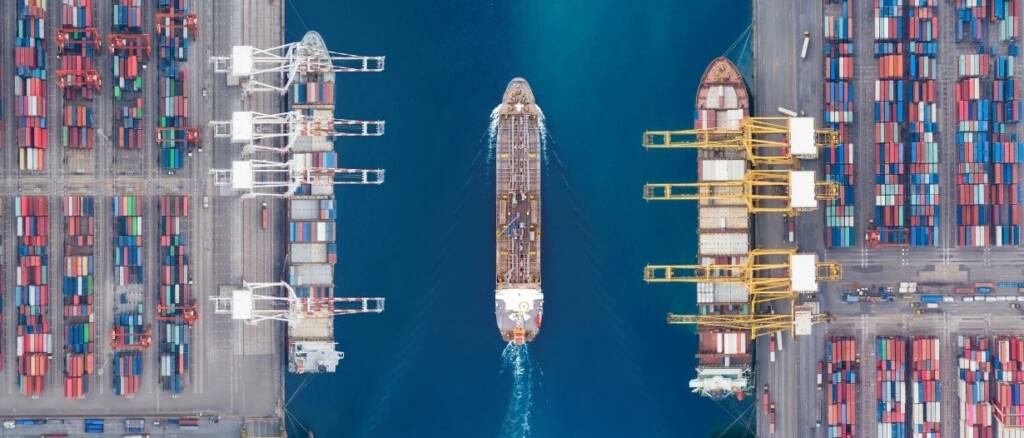Estimated reading time: 4 minutes
Almost every traded good in existence has sailed the high seas. The constant flow of products across oceans is necessary for meeting growing consumer demand. However, global shipping is also a significant driver of climate change, emitting more greenhouse gases than most countries. Here is how shipping and logistics companies can use technology to reduce the industry’s carbon footprint.

1. Improved ship design
Rounded hulls — a traditional ship shape — are falling out of favour in the cargo industry. Coupled with wind-assisted propulsion, sharp, slender ship designs lead to a 25% decrease in fuel use and greenhouse gas emissions, letting vessels slice through the waves like fish. It is good for the environment and shipping companies alike.
2. Battery propulsion
Smaller battery-powered ships solve two problems — size and emissions. Cargo ships are growing bigger by the year to reduce shipping costs, but this supersizing trend also reduces the number of ports where they can dock. Most ports are just not deep enough for ships with 20,000 containers onboard.
Battery-powered ships have to be smaller to accommodate the extra weight, which opens up more ports, alleviating waterway congestion. Lithium batteries are 80% lighter than their lead-acid counterparts, making them a good choice for smaller vessels. They also do not produce carbon emissions. Additionally, batteries offer a quieter experience for crew members and do not produce the noxious smell of burning diesel.
In 2021, Tokyo unveiled the e5 Tanker, the world’s first fully electric li-ion ship. Although still incomplete, it marks a new era for the shipping industry. New-Orleans-based Fleetzero is also designing small battery packs — which crew members could recharge at ports — to electrify ships. Battery propulsion is fast becoming a viable solution to address shipping emissions.
3. Alternative fuels
Most modern ships run on oil. Because burning oil releases carbon, switching to a different fuel is one of the most valuable ways the shipping industry could reduce its impact. Alternative options include methanol, ammonia, biofuel and green hydrogen.
Hydrogen stands out as the most attractive option because it is lightweight, energy dense and virtually unlimited — electrolyzers can split water into hydrogen and oxygen atoms. It also has fewer industrial uses than ammonia, methanol and biofuel.
In 2023, the International Maritime Organization (IMO) and European Union (EU) introduced new standards to help decarbonise ships, bringing alternative fuels to the forefront of shipping companies’ minds. The IMO 2023 aims to reduce commercial and private vessels’ carbon emissions by 40% by 2030 and 70% by 2050 compared to their 2008 levels. The EU’s Fit for 55 plan contains five items related to the shipping industry, requiring vessels sailing to and from European ports to purchase carbon allowances and taxing cargo ship fuel.
4. Carbon capture and storage
Many industries already embrace carbon capture and storage (CCS) technology, and the shipping sector seems poised to take advantage of it. CCS involves trapping carbon dioxide emissions before an industrial process releases them into the atmosphere. A mechanical component — such as a scrubber or membrane — holds onto the emissions until technicians can remove them and store them in a safe location underground.
Space constraints currently make installing CCS equipment onboard ships hard, but new designs could overcome this issue and make the technology feasible for oceanliners. Seabound, K Line and Value Maritime are a few companies developing carbon capture tech for ocean vessels. The equipment could connect to smokestacks and divert the exhaust into carbon-filtering containers, leaving just a small fraction of the normal emissions to escape.
5. Digital fleet management systems
Services like the Smart Ship Viewer use satellite communication equipment to let fleet managers check their ships’ status from the office. This fleet management technology allows for easier navigation, weather monitoring, route planning and equipment repair.
The improved efficiency it offers means ships can use less fuel. It also prevents breakdowns and delays that would contribute to carbon emissions.
6. Improved port design
New shipping technology addresses more than just the vessels themselves. Electrifying ports is a fantastic way to decarbonise the cargo industry, allowing electric ships to recharge while docked. The Port of Barcelona’s Nexigen plan aims to electrify the Spanish city’s docks to reduce greenhouse gas emissions. Carbon capture and storage systems in ports can also help decarbonize the industry.
7. Waste heat recovery
A waste heat recovery unit captures heat that would otherwise serve no purpose from a ship’s engines. This heat can power auxiliary equipment or generate electricity for other onboard processes. A heat recovery unit also means a vessel needs less fuel, improving energy efficiency and leading to less fossil fuel reliance.
8. The cargo industry is on course
New technology is making waves in the shipping industry, helping to decarbonize one of the world’s biggest polluters. The IMO and EU have introduced strong regulations to bring more cargo companies on board with the changes. Improved shipping routes, alternative fuels, sleek vessel designs and other technology are picking up steam, and the future of shipping looks much cleaner.
































